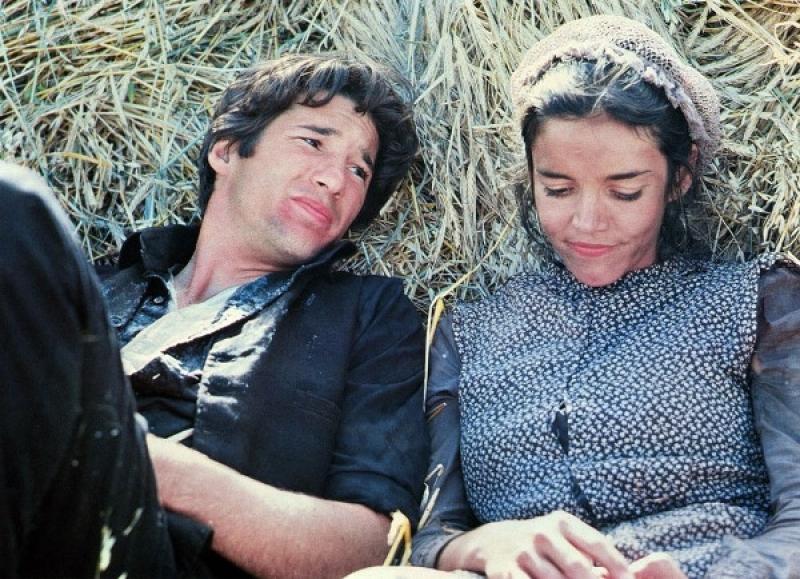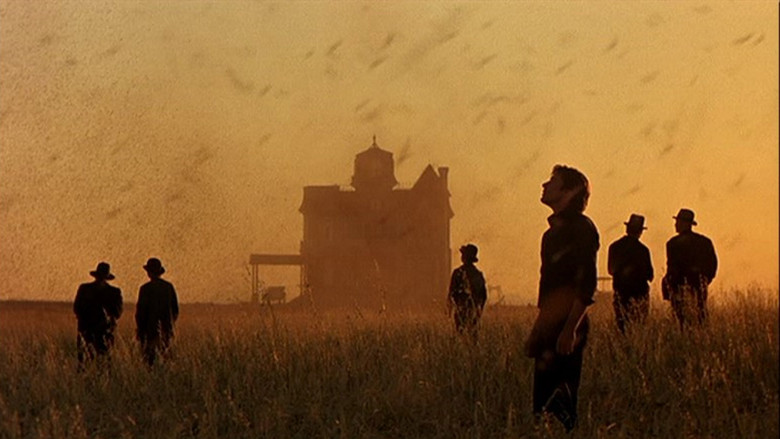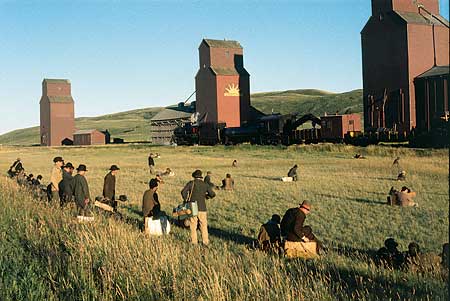Days of Heaven | reviews, news & interviews
Days of Heaven
Days of Heaven
Terrence Malick's groundbreaking second film remains a miracle of beauty and brevity

Days of Heaven made Terrence Malick’s legend. Released four years after his relatively conventional lovers-on-the-run debut Badlands (1974), it gave a similar story transcendental themes and images of painterly gorgeousness. Then he directed nothing else for 20 years. Choosing not to engage with interviews or celebrity, like Pynchon and Salinger he vanished into mystery and silence.
Filmed in 1976, it’s set 60 years before in the Texas Panhandle, where young lovers Bill (Richard Gere) and Abby (Brooke Adams), and her sister Linda (Linda Manz), flee from Chicago’s industrial hell to take in the harvest. The couple claim to be siblings, and when the land’s owner (Sam Shepard), who Bill finds has been given a year to live, falls for Abby, Bill encourages her to marry into the riches that will surely be theirs.
Nestor Almendros’s Oscar-winning cinematography is certainly luminous. Malick had him film whenever possible in the “magic hour” (20 minutes, really) of beautiful twilight, which cast and crew would spend the day feverishly readying for. A harvest moon is piercingly yellow, black horses are dusted by snow, and sun and candles light Shepard’s house on a hill. Gere, an unknown hopeful in 1976, and Adams, with her odd, upturned half-moon smile, are equally, naturally gorgeous.
 But Days of Heaven isn’t just picturesque. That reputation neglects the tightening dramatic noose around its lovers. The trio’s careless autumn idyll once harvest is over becomes heavy with sin and guilt. There’s more than a touch of The Postman Always Rings Twice’s noir doom, though these characters are less malign. Shepard’s unnamed illness is suspended by love for his new wife, then he sickens in mind and body as he only half-blinds himself to her cuckoldry. The camera rests on weather and wildlife, as impassive to the lovers’ fate as the Pacific tribesman in Malick’s eventual next film, The Thin Red Line, who lets US Marines warring on Guadalcanal pass him like ghosts. The cosmic fantasias of The Tree of Life, setting the tragedy of Brad Pitt’s 1950s family in the context of Earth’s whole existence, are Days of Heaven’s reveries blown up to infinite scale. Finally, plagues of locusts (shown in close-up as alien terrors) and fire chase the lovers downriver from their soiled Eden, repeating Badlands’ desperate flight. Their fate hurts, even as nature dwarfs it.
But Days of Heaven isn’t just picturesque. That reputation neglects the tightening dramatic noose around its lovers. The trio’s careless autumn idyll once harvest is over becomes heavy with sin and guilt. There’s more than a touch of The Postman Always Rings Twice’s noir doom, though these characters are less malign. Shepard’s unnamed illness is suspended by love for his new wife, then he sickens in mind and body as he only half-blinds himself to her cuckoldry. The camera rests on weather and wildlife, as impassive to the lovers’ fate as the Pacific tribesman in Malick’s eventual next film, The Thin Red Line, who lets US Marines warring on Guadalcanal pass him like ghosts. The cosmic fantasias of The Tree of Life, setting the tragedy of Brad Pitt’s 1950s family in the context of Earth’s whole existence, are Days of Heaven’s reveries blown up to infinite scale. Finally, plagues of locusts (shown in close-up as alien terrors) and fire chase the lovers downriver from their soiled Eden, repeating Badlands’ desperate flight. Their fate hurts, even as nature dwarfs it.
 Two decades later, half of Hollywood queued to work with Days of Heaven’s mythical creator on The Thin Red Line. John Travolta and George Clooney mostly ended on a cutting-room floor so knee-deep in waste Malick considered making a second film to go with the 170 minutes he released. Days of Heaven is by contrast a miracle of editing (Billy Weber cut both), its 94 minutes feeling richly epic. Linda Manz’s narration (a Malick speciality, adding shape to his sometimes amorphous tales) was itself edited from 60 hours of the 16-year-old’s half-grasped impressions of the scenes she was in. As her character floats down the river, she glimpses figures on its banks. “They were probably calling for help or somethin’, or they were tryin’ to bury somebody or somethin’,” she comments flatly, feeling herself by then to be in a dark fairy-tale world.
Two decades later, half of Hollywood queued to work with Days of Heaven’s mythical creator on The Thin Red Line. John Travolta and George Clooney mostly ended on a cutting-room floor so knee-deep in waste Malick considered making a second film to go with the 170 minutes he released. Days of Heaven is by contrast a miracle of editing (Billy Weber cut both), its 94 minutes feeling richly epic. Linda Manz’s narration (a Malick speciality, adding shape to his sometimes amorphous tales) was itself edited from 60 hours of the 16-year-old’s half-grasped impressions of the scenes she was in. As her character floats down the river, she glimpses figures on its banks. “They were probably calling for help or somethin’, or they were tryin’ to bury somebody or somethin’,” she comments flatly, feeling herself by then to be in a dark fairy-tale world.
Between Days of Heaven’s filming and its release, Star Wars all but buried the brief tradition of American art cinema that flourished in the early 1970s. Malick hibernated, but has somehow survived into 2011. Even amongst his own films, his second, digitally pared to a new perfection in this print, remains oddly, intimately grand.
Arriving in the panhandle: watch a clip from Days of Heaven
The future of Arts Journalism
You can stop theartsdesk.com closing!
We urgently need financing to survive. Our fundraising drive has thus far raised £33,000 but we need to reach £100,000 or we will be forced to close. Please contribute here: https://gofund.me/c3f6033d
And if you can forward this information to anyone who might assist, we’d be grateful.

Subscribe to theartsdesk.com
Thank you for continuing to read our work on theartsdesk.com. For unlimited access to every article in its entirety, including our archive of more than 15,000 pieces, we're asking for £5 per month or £40 per year. We feel it's a very good deal, and hope you do too.
To take a subscription now simply click here.
And if you're looking for that extra gift for a friend or family member, why not treat them to a theartsdesk.com gift subscription?
more Film
 Patrick McGilligan: Woody Allen - A Travesty of a Mockery of a Sham review - New York stories
Fair-minded Woody Allen biography covers all bases
Patrick McGilligan: Woody Allen - A Travesty of a Mockery of a Sham review - New York stories
Fair-minded Woody Allen biography covers all bases
 Blu-ray: Yojimbo / Sanjuro
A pair of Kurosawa classics, beautifully restored
Blu-ray: Yojimbo / Sanjuro
A pair of Kurosawa classics, beautifully restored
 Mr Burton review - modest film about the birth of an extraordinary talent
Harry Lawtey and Toby Jones excel as the future Richard Burton and his mentor
Mr Burton review - modest film about the birth of an extraordinary talent
Harry Lawtey and Toby Jones excel as the future Richard Burton and his mentor
 Restless review - curse of the noisy neighbours
Assured comedy-drama about an ordinary Englishwoman turned vigilante
Restless review - curse of the noisy neighbours
Assured comedy-drama about an ordinary Englishwoman turned vigilante
 Ed Atkins, Tate Britain review - hiding behind computer generated doppelgängers
Emotions too raw to explore
Ed Atkins, Tate Britain review - hiding behind computer generated doppelgängers
Emotions too raw to explore
 Four Mothers review - one gay man deals with three extra mothers
Darren Thornton's comedy has charm but is implausible
Four Mothers review - one gay man deals with three extra mothers
Darren Thornton's comedy has charm but is implausible
 Misericordia review - mushroom-gathering and murder in rural France
A deadpan comedy-thriller from the director of ‘Stranger by the Lake’
Misericordia review - mushroom-gathering and murder in rural France
A deadpan comedy-thriller from the director of ‘Stranger by the Lake’
 theartsdesk Q&A: filmmaker Joshua Oppenheimer on his apocalyptic musical 'The End'
The documentary director talks about his ominous first fiction film and why its characters break into song
theartsdesk Q&A: filmmaker Joshua Oppenheimer on his apocalyptic musical 'The End'
The documentary director talks about his ominous first fiction film and why its characters break into song
 DVD/Blu-ray: The Substance
French director Coralie Fargeat on the making of her award-winning body-horror movie
DVD/Blu-ray: The Substance
French director Coralie Fargeat on the making of her award-winning body-horror movie
 A Working Man - Jason Statham deconstructs villains again
A meandering vehicle for the action thriller star
A Working Man - Jason Statham deconstructs villains again
A meandering vehicle for the action thriller star
 The End review - surreality in the salt mine
Unsettling musical shows the lengths we go to avoid the truth
The End review - surreality in the salt mine
Unsettling musical shows the lengths we go to avoid the truth
 La Cocina review - New York restaurant drama lingers too long
Struggles of undocumented immigrants slaving in a Times Square kitchen
La Cocina review - New York restaurant drama lingers too long
Struggles of undocumented immigrants slaving in a Times Square kitchen

Add comment